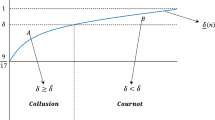Abstract
Increases in costs may have interesting, non-obvious effects on industry entry and exit. Three cases are possible when costs rise: the competitor neutral case, in which entry decreases and exit increases, entrant favoring, in which entry and exit both increase, and incumbent favoring, in which entry and exit both decrease. The model places restrictions on which outcomes are possible given which costs rise (marginal or fixed). The model can be used to examine the impacts of cost-increasing regulation or exogenous process innovation on industry entry and exit.
Access this article
We’re sorry, something doesn't seem to be working properly.
Please try refreshing the page. If that doesn't work, please contact support so we can address the problem.
Similar content being viewed by others
References
Amir R. and Lambson V. E. (2003). Entry, Exit and Imperfect Competition in the Long Run. Journal of Economic Theory 110: 191–203
Asplund, M., and Nocke, V. (2003): ``Firm Turnover in Imperfectly Competitive Markets''. Working Paper 03-010, PIER.
Baicker, K., and Chandra, A. (2004): ``The Effect of Malpractice Liability on the Delivery of Health Care''. Working Paper 10709, National Bureau of Economic Research.
Benkard C. L. (2004). A Dynamic Analysis of the Market for Wide-bodied Commercial Aircraft. Review of Economic Studies 71(3): 581–611
Bresnahan T. F. and Reiss P. C. (1990). Entry in Monopoly Markets. Review of Economic Studies 57(4): 531–553
Dixit A. (1980). The Role of Investment in Entry Deterrence. Economic Journal 90(357): 95–106
Ericson R. and Pakes A. (1995). Markov-perfect Industry Dynamics: A Framework for Empirical Work. Review of Economic Studies 62(1): 53–82
Ghemawat P. and Nalebuff B. (1985). Exit. RAND Journal of Economics 16: 184–194
Hopenhayn H. A. (1992). Entry, Exit and Firm Dynamics in Long-run Equilibrium. Econometrica 60(5): 1127–1150
Jovanovic B. (1982). Selection and the Evolution of Industry. Econometrica 50(3): 649–670
Klepper S. (1996). Entry, Exit, Growth and Innovation over the Product Life Cycle. American Economic Review 86(3): 562–583
Klepper S. (2002). Firm Survival and the Evolution of Oligopoly. RAND Journal of Economics 33(1): 37–61
Peretto P. F. (1996). Sunk Costs, Market Structure and Growth. International Economic Review 37(4): 895–923
Petrakis E. and Roy S. (1999). Cost Reducing Investment, Competition and Industry Dynamics. International Economic Review 40(2): 281–301
Prieger, J. E. (2004): ``The Impact of the Americans with Disabilities Act on the Entry and Exit of Retail Firms''. Working Paper 04-23, AEI-Brookings Joint Center for Regulatory Studies.
Roy, S., and Kamihigashi, T. (2004): ``Investment, Externalities and Industry Dynamics''. Unpublished manuscript.
Author information
Authors and Affiliations
Corresponding author
Rights and permissions
About this article
Cite this article
Prieger, J.E. The Impact of Cost Changes on Industry Entry and Exit. J Econ 91, 211–243 (2007). https://doi.org/10.1007/s00712-007-0245-7
Received:
Revised:
Published:
Issue Date:
DOI: https://doi.org/10.1007/s00712-007-0245-7



